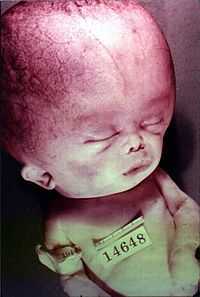Starchild skull

The Starchild skull is an abnormal human skull allegedly found in Mexico that was claimed to be the product of extraterrestrial-human breeding or genetic manipulation. Mitochondrial DNA recovered from the skull has established it as human.[1][2] Neurologist Steven Novella believes it to be the skull of a child who died as a result of congenital hydrocephalus.
Discovery
Paranormalist Lloyd Pye claimed to have obtained the skull from Ray and Melanie Young of El Paso, Texas, in February 1999. According to Pye, the skull was found around 1930 in a mine tunnel about 100 miles (160 km) southwest of Chihuahua, Mexico, buried alongside a normal human skeleton that was exposed and lying supine on the surface of the tunnel.[3][4]
Claims
Pye claimed the skull to be a hybrid offspring of an extraterrestrial and a human female.[1] According to Pye, a dentist who examined the upper right maxilla found with the skull determined that the skull was that of a child aged 4.5 to 5 years. The volume, however, of the interior of the starchild skull is 1,600 cubic centimeters, which is 200 cm³ larger than the average adult's brain, and 400 cm³ larger than an adult of the same approximate size. The orbits are oval and shallow, with the optic nerve canal situated closer to the bottom of the orbit than to the back. There are no frontal sinuses.[3] The back of the skull is flattened. The skull consists of calcium hydroxyapatite, the normal material of mammalian bone.

Neurologist Steven Novella of Yale University Medical School says that the cranium exhibits all of the characteristics of a child who has died as a result of congenital hydrocephalus, and the cranial deformations were the result of accumulations of cerebrospinal fluid within the skull.[1][2]
DNA testing
DNA testing in 1999 at BOLD (Bureau of Legal Dentistry), a forensic DNA lab in Vancouver, British Columbia found standard X and Y chromosomes in two samples taken from the skull, "conclusive evidence that the child was not only human (and male), but both of his parents must have been human as well, for each must have contributed one of the human sex chromosomes."[2]
Further DNA testing in 2003 at Trace Genetics, which specializes in extracting DNA from ancient samples, isolated mitochondrial DNA from both recovered skulls. The child belongs to haplogroup C. Since mitochondrial DNA is inherited exclusively from the mother, it makes it possible to trace the offspring's maternal lineage. The DNA test therefore confirmed that the child's mother was a Haplogroup C human female. However, the adult female found with the child belonged to haplogroup A. Both haplotypes are characteristic Native American haplogroups, but the different haplogroup for each skull indicates that the adult female was not the child's mother.[1]
References
- ↑ 1.0 1.1 1.2 1.3 Feder, Kenneth L. (2010). Encyclopedia of Dubious Archaeology: From Atlantis to the Walam Olum. ABC-CLIO. Retrieved March 17, 2011.
- ↑ 2.0 2.1 2.2 Novella, Steven. "The Starchild Project". The New England Skeptical Society. Retrieved March 17, 2011.
- ↑ 3.0 3.1 McCoy, Max (November 1999). "Star Child". Fortean Times (127): 42–45.
- ↑ "Alien skull' star attraction at Leeds extra-terrestrial conference". Yorkshire Evening Post. 27 June 2009. Retrieved 13 August 2011.